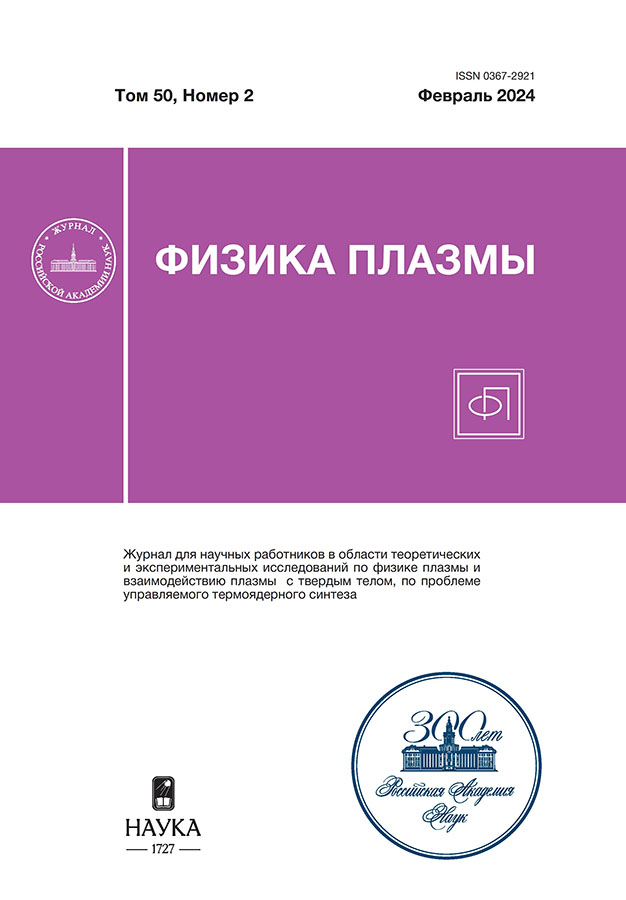Filament Formation Mechanism for a Nanosecond Surface Barrier Discharge. Part 2. The Local-Energy Approximation
- Autores: Soloviev V.R.1, Lisitsyn D.A.1, Karavaeva N.I.1
-
Afiliações:
- Moscow Institute of Physics and Technology (National Research University)
- Edição: Volume 50, Nº 2 (2024)
- Páginas: 255-266
- Seção: LOW TEMPERATURE PLASMA
- URL: https://cardiosomatics.ru/0367-2921/article/view/668809
- DOI: https://doi.org/10.31857/S0367292124020092
- EDN: https://elibrary.ru/QOMZYS
- ID: 668809
Citar
Texto integral
Resumo
The development of a surface barrier discharge driven by a negative steplike voltage pulse with an amplitude of V = –8 kV in air at the atmospheric pressure and a pulse with an amplitude of V = –15 kV in nitrogen at a pressure of 6 atm is simulated numerically. Calculations for V = –8 kV were carried out using the local-electric-field and the local-electron-energy approximations. It is demonstrated that both approximations yield similar results on the dynamics of discharge development as a whole, the cathode-layer structure, and the field distribution at the front of the discharge. Substantial differences are observed in parameters of the discharge layer adjacent to the dielectric surface, which allowed to simulate an effect similar to filamentation of the discharge in nitrogen at a pressure of 6 atm and voltage of V = –15 kV in the local-energy approximation.
Sobre autores
V. Soloviev
Moscow Institute of Physics and Technology (National Research University)
Autor responsável pela correspondência
Email: vic__sol@mail.ru
Rússia, Dolgoprudny, Moscow oblast, 141700
D. Lisitsyn
Moscow Institute of Physics and Technology (National Research University)
Email: vic__sol@mail.ru
Rússia, Dolgoprudny, Moscow oblast, 141700
N. Karavaeva
Moscow Institute of Physics and Technology (National Research University)
Email: vic__sol@mail.ru
Rússia, Dolgoprudny, Moscow oblast, 141700
Bibliografia
- Stepanyan S.A., Starikovskiy A. Yu., Popov N. A., Starikovskaia S. M. // Plasma Sources Sci. Technol. 2014. V. 23. P. 045003.
- Shcherbanev S.A., Ding Ch., Starikovskaia S. M., Popov N. A. // Plasma Sources Sci. Technol. 2019. V. 28. P. 065013
- Ding Ch., Khomenko A. Yu., Shcherbanev S. A., Starikovskaia S. M. // Plasma Sources Sci. Technol. 2019. V. 28. P. 085005
- Shcherbanev S.A, Popov N. A., Starikovskaia S. M. // Combustion and Flame. 2017. V. 176. P. 272.
- Ding Ch, Jean A, Popov N. A., Starikovskaia S. M. // Plasma Sources Sci. Technol. 2022. V. 31. P. 045013.
- Соловьев В.Р. // Физика плазмы. 2022. Т. 48. С. 552.
- Соловьев В.Р., Лисицын Д. А., Караваева Н. И. // Физика плазмы. 2023. Т.50. С. 122.
- Soloviev V.R., Anokhin E. M., Aleksandrov N. L. // Plasma Sources Sci. Technol. 2020. V. 29. P. 035006.
- Дятко Н.А., Кочетов И. В., Напартович А. П. // Физика плазмы. 1992. Т. 18. С. 888.
- Зельдович Я.Б., Райзер Ю. П. Физика ударных волн и высокотемпературных гидродинамических явлений. М.: Наука. 1966. С. 394.
- Soloviev V.R. // J. Phys.: Confer. Ser. 2020. V. 1698. P. 012026.
- Soloviev V. R., Krivtsov V. M. // Plasma Sources Sci. Technol. 2018. V. 27. P. 114001.
- Смирнов Б. М. Ионы и возбужденные атомы в плазме. М.: Атомиздат, 1974. С. 264, 271.
- Полак Л.С., Словецкий Д. И., Соколов А. С. // Химия высоких энергий. 1972. T. 6. № 5. C. 396.
- Попов Н. А. Физика плазмы. 2013. Т. 39. С. 483.
Arquivos suplementares










